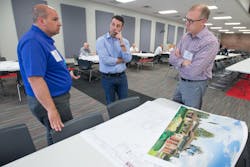Savings for the Station Design Conference Ends Soon
Editor's Note: Thursday. March 15 is the last chance to save up to $55 off your 2018 Station Design Conference registration rates. Register now!
One of the most frequent comments we hear from fire chiefs and officers at the Station Design Conference is, “I wish we’d learned this sooner!”
If your department has started talking about a new fire station, then it’s not too early to start learning the hard-hitting questions you need to answer before sketching designs for your new station or renovation.
The old fire service adage of “200 years of tradition unimpeded by progress” does not apply to fire stations today. Over the past 10 years—and less—the scope of fire service responsibilities has dramatically changed the requirements for fire stations: gender-neutrality, personnel security, wireless technology and the most recent focus on decontamination "zones" and cancer prevention for firefighters and EMS personnel.
It’s almost a misnomer to say "fire station" because these facilities are not just garages for fire apparatus and a place to house firefighters who put out just fires. The roles have expanded to fire, rescue and EMS departments and demand additional space for storing the variety of equipment and gear required for each response. Besides administrative offices, new responsibilities also require designated space for training in classrooms and hands-on—inside and out—of the facility.
Volunteer departments, which often require room for the social aspects of their community, must consider the decrease in volunteers and must consider space for transitioning to full-time personnel.
Research has shown turnout gear should no longer hang in apparatus bays. It requires an enclosed area with a separate air ventilation system. Cleaning and storage of additional sets of gear must also be considered.
Are you up to date on the American with Disabilities Act (ADA) compliance, new National Fire Protection Association (NFPA) standards that apply to new public safety facilities, Leadership in Energy and Environmental Design (LEED) or sustainability, and the latest issues of "zone" designs, restricting contamination in the station and sleep deprivation health issues?
New construction is not cheap and without question, the cost of a new station is startling if you don’t understand why or even when you do it. The best way to save money on your new station, avoid costly errors and save time is to do your homework. And the sooner you start doing your homework, the better the results will be.
The Firehouse Station Design Conference is a focused, niche conference. We work hard for it to be a win-win for every person that attends. The sponsors and vendors are people we have worked with—some for many years—are eager to share their knowledge.
As a Station Design Conference attendee, we want you to learn as much as you can, ask as many questions as you can, so you feel confident to work on your new station. And if you come back a second year after you start your process, we’re betting you’ll find even more help on your journey to validate your decisions.
Some of the 2018 Station Design Conference sessions include:
- Let's get a Lasso around your Project, by Ken Newell, Stewart-Cooper-Newell Architects
- Case Study: How to Meet the Budget, by Mary McGrath, AIA LEED AP, Mary McGrath Architects and Larry Rooney, Assistant Chief, Avondale, AZ
- 2-in-1: a Case Study on a New Station, Renovation and Addition, by Theodore Galante, The Galante Architecture Studio
- Fighting Firefighter Cancer and Hot Zone Design, by Paul R. Erickson, AIA, LEED AP and Keith Tyson, FFCSN
